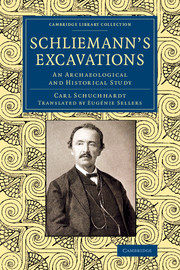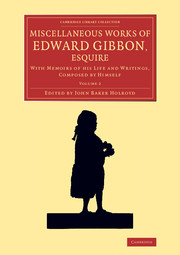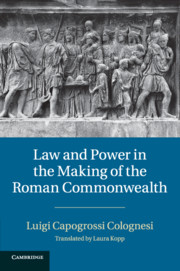Refine search
Actions for selected content:
23990 results in Ancient history

Schliemann's Excavations
- An Archaeological and Historical Study
-
- Published online:
- 05 November 2014
- Print publication:
- 17 April 2014

Miscellaneous Works of Edward Gibbon, Esquire
- With Memoirs of his Life and Writings, Composed by Himself
-
- Published online:
- 05 November 2014
- Print publication:
- 17 April 2014
- First published in:
- 1796

Law and Power in the Making of the Roman Commonwealth
-
- Published online:
- 05 November 2014
- Print publication:
- 13 November 2014
CHAP. I - AMON-RA, BAAL, JEHOVAH, AND ANCIENT EGYPT
-
- Book:
- Universal History
- Published online:
- 05 January 2015
- Print publication:
- 30 October 2014, pp 1-28
-
- Chapter
- Export citation
INDEX
-
- Book:
- Universal History
- Published online:
- 05 January 2015
- Print publication:
- 30 October 2014, pp 491-501
-
- Chapter
- Export citation
CHAP. III - TYRE AND ASSUR
-
- Book:
- Universal History
- Published online:
- 05 January 2015
- Print publication:
- 30 October 2014, pp 61-90
-
- Chapter
- Export citation
PREFACE
-
- Book:
- Universal History
- Published online:
- 05 January 2015
- Print publication:
- 30 October 2014, pp ix-xiv
-
- Chapter
- Export citation
Frontmatter
-
- Book:
- Universal History
- Published online:
- 05 January 2015
- Print publication:
- 30 October 2014, pp i-iv
-
- Chapter
- Export citation
EDITOR'S PREFACE
-
-
- Book:
- Universal History
- Published online:
- 05 January 2015
- Print publication:
- 30 October 2014, pp v-viii
-
- Chapter
- Export citation
CHAP. XII - A GLANCE AT CARTHAGE AND SYRACUSE
-
- Book:
- Universal History
- Published online:
- 05 January 2015
- Print publication:
- 30 October 2014, pp 475-490
-
- Chapter
- Export citation
CHAP. VI - THE ENCOUNTER BETWEEN THE GREEKS AND THE PERSIAN EMPIRE
-
- Book:
- Universal History
- Published online:
- 05 January 2015
- Print publication:
- 30 October 2014, pp 155-195
-
- Chapter
- Export citation
Contents
-
- Book:
- Universal History
- Published online:
- 05 January 2015
- Print publication:
- 30 October 2014, pp xv-xvi
-
- Chapter
- Export citation
CHAP. VII - THE ATHENIAN DEMOCRACY AND ITS LEADERS
-
- Book:
- Universal History
- Published online:
- 05 January 2015
- Print publication:
- 30 October 2014, pp 196-283
-
- Chapter
- Export citation
CHAP. IX - THE RELATIONS OF PERSIA AND GREECE DURING THE FIRST HALF OF THE FOURTH CENTURY
-
- Book:
- Universal History
- Published online:
- 05 January 2015
- Print publication:
- 30 October 2014, pp 347-371
-
- Chapter
- Export citation
CHAP. X - THE UNIVERSAL MONARCHY OF MAKEDONIA
-
- Book:
- Universal History
- Published online:
- 05 January 2015
- Print publication:
- 30 October 2014, pp 372-446
-
- Chapter
- Export citation
CHAP. XI - ORIGIN OF THE GRÆCO-MAKEDONIAN KINGDOMS
-
- Book:
- Universal History
- Published online:
- 05 January 2015
- Print publication:
- 30 October 2014, pp 447-474
-
- Chapter
- Export citation
CHAP. VIII - ANTAGONISM AND GROWTH OF RELIGIOUS IDEAS IN GREEK LITERATURE
-
- Book:
- Universal History
- Published online:
- 05 January 2015
- Print publication:
- 30 October 2014, pp 284-346
-
- Chapter
- Export citation
CHAP. V - ANCIENT HELLAS
-
- Book:
- Universal History
- Published online:
- 05 January 2015
- Print publication:
- 30 October 2014, pp 118-154
-
- Chapter
- Export citation
CHAP. II - THE TWELVE TRIBES OF ISRAEL
-
- Book:
- Universal History
- Published online:
- 05 January 2015
- Print publication:
- 30 October 2014, pp 29-60
-
- Chapter
- Export citation
CHAP. IV - THE MEDO-PERSIAN KINGDOM
-
- Book:
- Universal History
- Published online:
- 05 January 2015
- Print publication:
- 30 October 2014, pp 91-117
-
- Chapter
- Export citation
